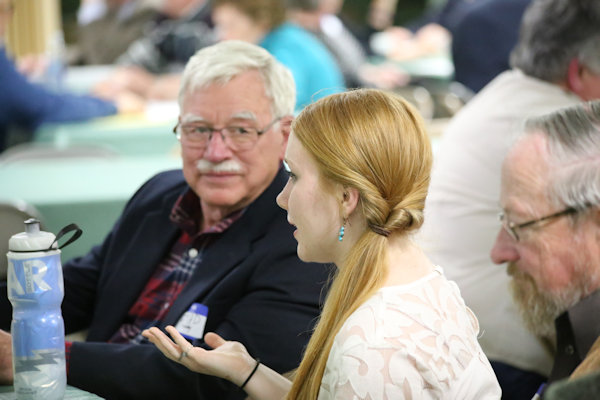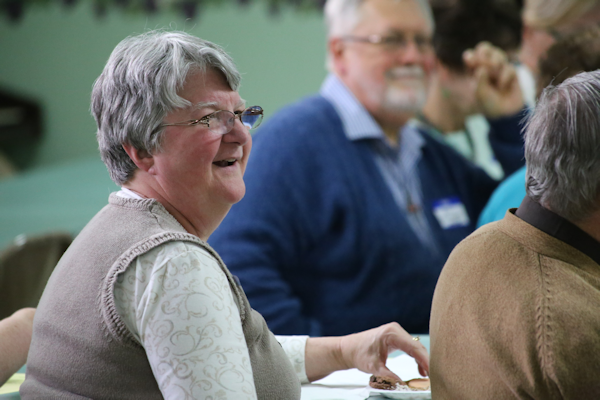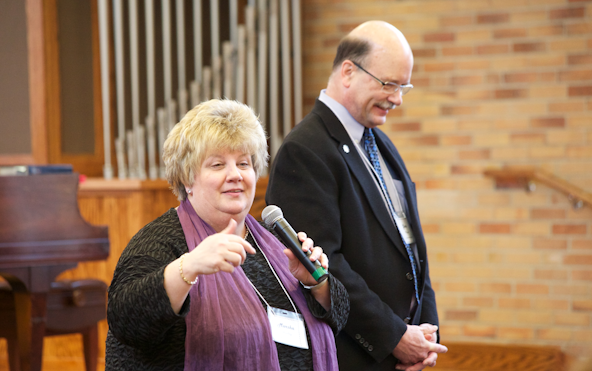The New Conference Design Team reports on their six-site Listening Tour that finished on April 28th.
KAY DeMOSS
Senior Editor-Writer, Michigan Area
Members of the Michigan Conference Design Team took their listening tour to Northern Michigan in April with visits to Michelson Memorial UMC in Grayling and Memorial UMC in Gladstone.
Sixty persons gathered in Grayling on April 27th from churches across the northern Lower Peninsula. Participants included a team from the Wesley Foundation at Central Michigan University, who took a break from their preparation for final exams to take part.
Upper Peninsula clergy and lay leaders came to Gladstone on April 28th. Participants at both sessions reflected on the Vision for a new conference, a statement that has been revised by the Design Team in response to feedback received during the previous four listening sessions.
Evolving Vision
Aimed at identifying what United Methodists want to be known for across the State, the revised Vision Statement now reads:
The Michigan Conference equips and connects through: Christ-centered mission and ministry; Bold, effective leaders; Vital congregations.
The Vision Statement will inform strategies, align resources, make decisions, and evaluate ministry.
The Design Team has received consistent feedback at all listening sessions that verbs are needed to provide action and direction to the Vision. The Design Team has proposed that equipping and connecting vital congregations and bold effective leaders for Christ-centered mission and ministry are the two primary roles filled by our conference.
Connecting is particularly important in both the Northern Lower Peninsula and the Upper Peninsula where vast distances between churches and Conference Centers make effective connecting a challenge. New models of organization and modes of technology are essential.

One Gladstone participants invited the church to consider finding new ways to connect congregations at the western edge of the Upper Peninsula via cross-conference partnering with congregations and resourcing in the Wisconsin Conference. Closer proximity would facilitate such alliances.
Christ at the center
The new version of the Vision also reorders the focus of the Conference.
From the beginning of its work the Design Team has agreed that there be no hierarchy of importance implied in the three elements originally listed: Bold, effective leaders; Vital congregations; and Christ-centered mission and ministry.
Nevertheless, listening session respondents have consistently commented that priority is implied by what is listed first. Participants have also agreed that Christ-centered mission and ministry should be the Conference’s first priority.
Therefore, Christ-centered mission and ministry is now the first task listed in the revised Vision Statement. A new graphic for the Vision, being prepared to share at Annual Conference in June, will depict inter-connectedness.
Up North listening sessions also heard statements from the Book of Discipline, among them:
The purpose of the Annual Conference is to make disciples of Jesus Christ for the transformation of the world by equipping its local churches for ministry and by providing a connection for ministry beyond the local church; all to the glory of God.”
Feedback given
Listening session participants shared enthusiasm for a new conference organized around the proposed Vision. They suggested that a new vision will influence the shape and content of annual conference sessions and could see how required paperwork from local churches and the putting together of a conference budget should also reflect the stated priorities of this new Vision.
It was clear to participants that with such a vision in place, faith development, outward focus, leadership training, and disciple-making would be priorities. By defining words in the vision like vital and effective, measures for accountability for both clergy and laity could be established. Hope was expressed that a church that lives into the Vision will be able to reverse recent decline.

Participants shared excitement about doing church in a new way. They offered hopes that a new conference would be more nimble in its ministry and would benefit from administrative efficiencies. They voiced enthusiasm for moving beyond an us vs. them mentality between the conferences and liked that pastoral appointments could be made more effectively by drawing on an expanded pool of clergy gifts around the state. Participants were also honest with their fears that nothing would change or that change would adversely affect cherished programs currently supported by connectional budgets.
Calls to action were issued at both sessions and participants were invited to begin taking concrete steps to begin to live into the Vision.
Next steps
Conference Boards, agencies, and committees have started to meet with counterparts across conference lines.
The May meeting of the Design Team meeting will include presentations by chairs of the Detroit and West Michigan Conference Trustees about property issues and space concerns. The Team will also be preparing a presentation to be made at Annual Conference on June 10th. Conference legislation in 2016 will include enabling motions that will move the work of the Design Team forward.
The Design Team will remain alert to actions taken by General Conference before firming up any recommendations regarding districting, personnel, property, and structure for the new conference.
The intention is for such specific recommendations to be presented via another series of listening sessions across the state in late fall of 2017. The Design Team anticipates a proposed plan will be presented to the 2017 Annual Conference sessions.
Comments are always welcome at DesignTeam@MIareaUMC.org
~Design Team co-chairs Rev. Glenn Wagner and Rev. Marsha Woolley contributed to this report.
Last Updated on December 15, 2023

